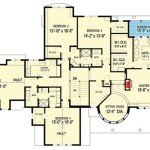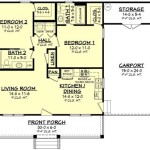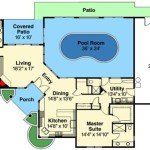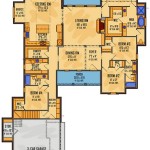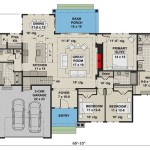Finding the Floorplan of Your House: A Comprehensive Guide
Locating the floorplan of a house can be essential for various reasons, ranging from planning renovations to assessing property value. The floorplan provides a visual representation of the property's layout, showing the arrangement of rooms, dimensions, and structural elements. This article explores various methods for finding a house's floorplan, offering practical advice and resources to assist in the search.
Checking Existing Documentation and Records
The first step in locating a house's floorplan involves examining existing documentation. This includes paperwork related to the property such as the original purchase documents, mortgage records, homeowner's insurance policies, and any previous renovation permits. These documents may contain a floorplan or reference its location.
When examining purchase documents, look for appendices or attachments that might include the floorplan. The purchase agreement itself may reference architectural drawings or blueprints that were part of the initial sale. Similarly, mortgage documents might include a formal appraisal of the property, which, in certain cases, includes a basic floorplan sketch.
Homeowner's insurance policies typically contain information about the property's square footage and layout. While not always including a detailed floorplan, the insurance documents can provide valuable clues and may even refer to an existing floorplan filed with the insurance company.
Previous renovation permits are a particularly valuable resource. If the house has undergone any significant renovations or additions, the local building department would likely have required the submission of detailed floorplans as part of the permit application. These plans, which are often available for public viewing, can offer a comprehensive view of the house's current layout.
Furthermore, if the house was built relatively recently, the developer or builder might maintain records of the original floorplans. Contacting the developer or builder of the subdivision could be fruitful, especially if the house is part of a planned community or development.
Finally, online property databases maintained by local governments or real estate agencies sometimes include scanned copies of floorplans. These databases vary in quality and completeness, but checking them can be a quick and efficient method for potentially finding the desired information.
Consulting Local Government and Municipal Resources
Local government agencies, particularly city or county planning departments and building departments, often maintain extensive records related to properties within their jurisdiction. These records may include floorplans, construction permits, and site surveys, all of which can provide valuable information about a house's layout.
The building department is a primary resource for obtaining floorplans, especially if the house has undergone any renovations or additions. When requesting information, it's important to provide the property address and any relevant details, such as the approximate year of construction or the names of previous owners. The building department may have digital or physical copies of floorplans that were submitted as part of permit applications. In some cases, accessing these records may require a small fee.
The planning department is another potential source of information. They often maintain records of site plans, which show the location of structures on a property and may include details about the building's footprint and layout. While a site plan is not the same as a detailed floorplan, it can provide useful information about the overall dimensions and configuration of the house.
Property assessor's offices also maintain records of properties, including information about their size, features, and improvements. While they may not have detailed floorplans, they often possess sketches or diagrams that illustrate the basic layout of the house. These sketches can be useful for understanding the overall structure and arrangement of rooms.
Accessing these government records often requires a formal request, either in person or online. It's advisable to contact the relevant department beforehand to inquire about their procedures for accessing records and any associated fees. Be prepared to provide the property address and any other information that may help them locate the desired documents.
Additionally, some municipalities offer online portals where residents can access property records and maps. These portals may include scanned copies of floorplans or other relevant documents. Checking these online resources can be a convenient way to access information without having to visit the government office in person.
Creating a Floorplan Yourself
If existing documentation and public records do not yield a floorplan, creating one oneself becomes necessary. This can be achieved through various methods, ranging from manual measurement and sketching to using specialized software and laser measuring tools.
The most basic method involves manually measuring the dimensions of each room and drawing a sketch based on those measurements. This requires a measuring tape, a pencil, and graph paper. Start by sketching the outline of the house, then measure the length and width of each room and draw them to scale on the graph paper. Be sure to include the locations of doors, windows, and any other significant features.
Accuracy is crucial when creating a floorplan manually. Take multiple measurements of each room to ensure consistency, and pay close attention to the angles of walls and corners. It can be helpful to work with a partner, one person taking the measurements and the other recording them.
For more accurate and professional-looking floorplans, consider using digital floorplan software. Various software options are available, ranging from free online tools to more sophisticated paid programs. These software programs allow users to create floorplans digitally, using precise measurements and incorporating symbols for doors, windows, and other features.
Some popular floorplan software options include SketchUp, AutoCAD, and RoomSketcher. These programs offer a range of features, including the ability to create 3D models, add furniture and fixtures, and generate detailed reports. While some software programs require training or experience to use effectively, others are relatively user-friendly and can be learned quickly.
To further enhance accuracy, consider using a laser measuring tool. These devices use laser technology to measure distances quickly and accurately, eliminating the need for manual tape measurements. Laser measuring tools can significantly speed up the floorplan creation process and reduce the risk of errors.
Once the floorplan is created, it can be used for various purposes, such as planning renovations, arranging furniture, or creating marketing materials for selling or renting the property. A well-drawn floorplan provides a valuable visual representation of the house's layout and can be an indispensable tool for homeowners and real estate professionals alike.
Utilizing Real Estate Resources and Professionals
Real estate professionals, including real estate agents, appraisers, and property surveyors, possess expertise and resources that can aid in finding or creating a house's floorplan. Engaging their services can be a valuable investment, particularly when other methods have proven unsuccessful.
Real estate agents often have access to databases and resources that include floorplans for properties listed for sale or rent. They might be able to provide a floorplan from a previous listing of the house, or they can create a new floorplan as part of their marketing efforts. When contacting real estate agents, it's helpful to provide them with the property address and any relevant details, such as the year of construction or the names of previous owners.
Appraisers are trained to assess the value of properties, and they often create floorplan sketches as part of their appraisal reports. While these sketches may not be as detailed as formal architectural drawings, they can provide a useful overview of the house's layout and dimensions. Requesting a copy of a previous appraisal report can be a way to obtain a floorplan of the house.
Property surveyors are professionals who specialize in measuring and mapping land and property boundaries. They can create detailed site plans that show the location of structures on a property, including the house. While a site plan does not provide a room-by-room floorplan, it can offer valuable information about the house's footprint and orientation on the lot.
Architects and draftspersons can also be hired to create a floorplan of a house. They can take precise measurements of the house and create detailed drawings that meet professional standards. This option is particularly useful if the house has undergone significant renovations or additions, or if a highly accurate and detailed floorplan is required.
When engaging the services of real estate professionals, it's important to clearly communicate your needs and expectations. Discuss the level of detail required in the floorplan and the purpose for which it will be used. Obtain quotes from multiple professionals to compare their fees and services, and choose the option that best meets your requirements.
In addition to professional services, online real estate platforms and databases often include floorplans for properties listed for sale or rent. Checking these online resources can be a convenient way to access floorplans for houses in a specific area. Websites like Zillow, Realtor.com, and Trulia often include floorplans as part of their property listings.
Considering Historical Societies and Archives
For older homes, historical societies and local archives can potentially hold valuable information, including original floorplans or other documents that provide insights into the property's layout and history. These organizations often preserve historical records, photographs, and maps that can be useful in tracing a property's evolution over time.
Historical societies are dedicated to preserving the history of a specific area or community. They often maintain collections of historical documents, photographs, and artifacts that relate to local properties. Contacting the local historical society can be a way to uncover information about the house's original design and layout.
Local archives, such as city or county archives, are repositories of government records, historical documents, and other materials that document the history of the area. These archives may contain building permits, construction plans, and other documents that include floorplans or other relevant information.
When contacting historical societies or archives, it's important to provide them with as much information as possible about the house, including its address, approximate year of construction, and the names of previous owners. They may be able to search their records for relevant documents or information.
Visiting the historical society or archive in person can be a worthwhile endeavor, as browsing through their collections may reveal unexpected finds. Many historical societies and archives also have online databases or catalogs that allow researchers to search for documents remotely.
Keep in mind that accessing historical records may require adhering to specific procedures and paying fees. The availability of records may also be limited depending on their age and condition. However, for those interested in the history of their home, historical societies and archives can be a valuable resource.
Moreover, libraries, particularly those with local history collections, can also be useful resources. They may hold books, maps, and other materials that provide information about local properties and their histories.

Archimple Finding Building Plans And Floor For Your House Tips Resources

How To Find The Original Floor Plans For Your House

9 Ways To Find Floor Plans Of An Existing House Archid

As Built Floor Plans

Archimple How To Find Floor Plans For My Apartment Unlocking The Blueprint Of Your Ideal Living Space

Design Your Own House Floor Plans Roomsketcher

Design Your Own House Floor Plans Roomsketcher

Archimple How To Find Floor Plans For My Apartment Unlocking The Blueprint Of Your Ideal Living Space

How To Read A Floor Plan With Dimensions Houseplans Blog Com

How To Read Floor Plans



